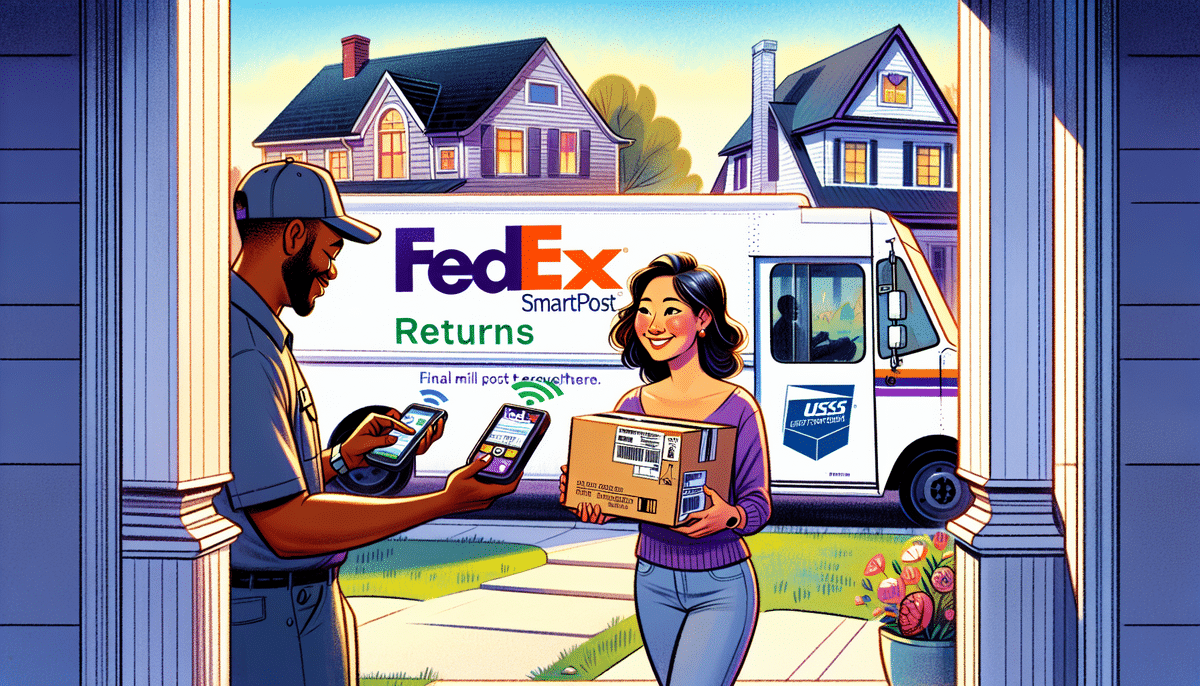How to Return an Item with FedEx: An SEO-Optimized Guide
Returning an item with FedEx is a straightforward process that can be completed efficiently by following a few key steps. As a leading global shipping company, FedEx offers a variety of return options to cater to different customer needs. This guide provides a comprehensive overview of how to return an item with FedEx, including step-by-step instructions, best practices, and essential tips for a seamless return experience.
Benefits of Using FedEx for Returns
FedEx provides numerous advantages for customers looking to return items, making it a preferred choice for many retailers and consumers alike:
- Wide Retail Partnerships: Many retailers partner with FedEx to offer hassle-free return experiences, enhancing customer satisfaction and loyalty.
- Extensive Network: With a vast network of shipping locations and pickup options, FedEx ensures that customers can return items conveniently from almost anywhere.
- Real-Time Tracking: FedEx offers robust tracking capabilities, allowing both customers and retailers to monitor the status and location of return shipments in real-time.
- Flexible Return Options: Customers can choose to drop off returns at FedEx locations, schedule pickups, or use FedEx drop boxes, providing flexibility to accommodate various schedules and locations.
- Variety of Packaging Options: FedEx supplies a range of packaging materials, including boxes, envelopes, and labels, and offers free packaging supplies for certain return types, ensuring items are securely packaged.
According to [Statista](https://www.statista.com/statistics/220858/us-fedex-net-income/), FedEx reported a net income of $5.58 billion in 2022, underscoring its robust infrastructure and reliability in the shipping industry.
Step-by-Step Guide to Returning an Item with FedEx
- Review the Retailer's Return Policy: Before initiating a return, ensure that you are eligible by reviewing the retailer's return policy, which outlines conditions such as time frames and item eligibility.
- Obtain or Create a Return Label: Use the return label provided by the retailer or generate one through FedEx's online label generator.
- Prepare the Package: Securely package the item using appropriate materials to prevent damage during transit. Include any required documentation, such as receipts or return forms.
- Attach the Return Label: Affix the return label to the package, ensuring it is clearly visible and securely attached.
- Choose a Return Method: Drop off the package at a designated FedEx location, schedule a pickup, or utilize a FedEx drop box for added convenience.
Remember to keep your tracking number for reference and to monitor the status of your return shipment.
Preparing Your Package for a Successful Return
Properly preparing your package is crucial to ensure the safe and timely return of your item:
- Select the Right Packaging: Use a sturdy box or envelope that appropriately fits the item to minimize movement during transit.
- Protect the Item: Cushion the item with materials like bubble wrap, packing peanuts, or foam inserts to prevent damage.
- Seal Securely: Use high-quality packing tape to seal all openings of the package firmly.
- Include Documentation: Place any necessary paperwork, such as return authorization forms or receipts, inside the package to facilitate processing.
- Label Clearly: Ensure the return address and any special handling instructions (e.g., "Fragile") are clearly marked on the package.
For fragile items, consider double-boxing to provide additional protection during transit.
Tracking and Monitoring Your FedEx Return Shipment
FedEx offers comprehensive tracking tools to help you stay informed about the status of your return:
- Online Tracking: Use the FedEx Tracking tool by entering your tracking number to view real-time updates on your package's location and delivery status.
- Email and SMS Alerts: Sign up for notifications to receive automatic updates on your return shipment directly to your email or mobile device.
- FedEx Mobile App: Utilize the FedEx mobile app for on-the-go tracking and management of your shipments.
Proactive tracking helps ensure that any issues are promptly addressed, and provides peace of mind throughout the return process.
Understanding FedEx Return Policies and Fees
FedEx's return policies and associated fees can vary based on the retailer and the specific service chosen:
- Retailer-Specific Policies: Some retailers offer free return shipping, while others may require customers to cover return costs. Always review the retailer's return policy beforehand.
- Service Options: FedEx provides various return services, including FedEx Ground, FedEx Express, and FedEx International. Each service comes with different pricing and delivery times.
- Additional Fees: Extra services such as package pickup scheduling, insurance, and signature confirmation may incur additional charges.
For detailed pricing information, visit the FedEx Shipping Services page.
Best Practices for a Seamless Return Experience
To ensure a smooth and efficient return process with FedEx, consider the following best practices:
- Timely Returns: Initiate your return as soon as possible to comply with the retailer's return window and avoid potential delays.
- Accurate Documentation: Include all necessary paperwork and ensure that the return label is correctly attached to prevent processing errors.
- Secure Packaging: Protect your item adequately to prevent damage, which could complicate the return or lead to additional costs.
- Confirm Address Details: Double-check both the sender's and recipient's addresses on the package to ensure correct delivery.
- Utilize Tracking: Monitor your return shipment to stay informed about its progress and address any issues promptly.
By adhering to these practices, you can enhance the likelihood of a hassle-free return experience.
Common Reasons for Returning Items with FedEx
Customers may need to return items for various reasons, including:
- Damaged or Defective Products: Items that are damaged upon arrival or do not function as intended.
- Incorrect Orders: Receiving the wrong item or specifications that do not match the order.
- Change of Mind: Deciding not to keep the item after purchase.
- Size or Fit Issues: Especially common with apparel and footwear, where the item does not fit as expected.
Understanding the reason for your return can help in communicating effectively with the retailer and ensuring a smoother return process.
Avoiding Common Mistakes When Returning with FedEx
To prevent common pitfalls during the return process, keep these tips in mind:
- Not Reviewing the Return Policy: Failing to understand the retailer's specific return conditions can result in denied returns.
- Poor Packaging: Inadequate packaging may lead to item damage and complicate the return.
- Missing Documentation: Omitting necessary paperwork can delay processing and refunds.
- Incorrect Labeling: Errors in the return address or labeling can cause delivery issues.
- Neglecting to Track the Shipment: Without tracking, it's difficult to verify that the return has been received by the retailer.
By being mindful of these common mistakes, you can enhance the efficiency and success of your return.
Options for Refunds and Exchanges
The outcome of your return—whether a refund, exchange, or store credit—is determined by the retailer's policies:
- Full Refunds: Many retailers offer a complete refund for returned items, provided they are in original condition and returned within the specified timeframe.
- Exchanges: If you prefer a different size, color, or model, retailers may allow you to exchange the item for an alternative product.
- Store Credit: Some retailers provide store credit instead of a cash refund, which can be used for future purchases.
Always confirm the specific refund and exchange options available by consulting the retailer's return policy before initiating a return.
Scheduling a Pickup for Your FedEx Return Shipment
If dropping off your return at a FedEx location is inconvenient, you can schedule a pickup:
- Online Scheduling: Use the FedEx Pickup Service to arrange a collection at your preferred time and location.
- Pickup Requirements: Ensure that the package is ready for pickup, properly labeled, and that you have the necessary documentation prepared.
- Pickup Confirmation: After scheduling, you will receive a confirmation with details about your pickup request.
Scheduling a pickup can save time and add convenience, especially for bulky or multiple return packages.
Ensuring the Safe Return of Fragile Items
When returning fragile items, extra precautions are necessary to prevent damage during transit:
- Use Protective Materials: Wrap the item thoroughly with bubble wrap, packing paper, or foam to absorb impacts.
- Choose Durable Packaging: Select a sturdy box that can withstand handling and movement.
- Double-Boxing: Place the wrapped item inside a smaller box, then into a larger box with additional cushioning for enhanced protection.
- Label as Fragile: Clearly mark the package with "Fragile" labels to alert handlers to handle the package with care.
Implementing these best practices significantly reduces the risk of damage to delicate items during the return process.
Conclusion
Returning an item with FedEx is a user-friendly process that, when approached with careful planning and adherence to best practices, can be executed smoothly and efficiently. By understanding the benefits, following the step-by-step guide, preparing your package correctly, and leveraging FedEx's tracking and pickup services, you can ensure a hassle-free return experience. Additionally, being aware of the common reasons for returns and avoiding typical mistakes will further streamline the process. Whether you're dealing with standard returns or handling fragile items, FedEx provides the tools and services necessary to facilitate successful returns.








